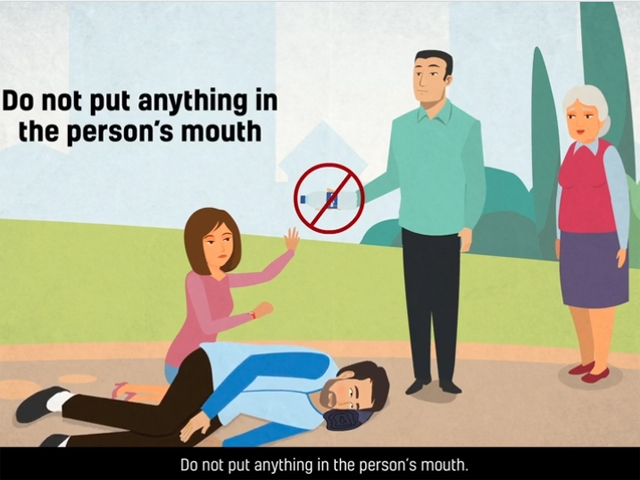Carol Ireland Purple Day Interview

Do you know what to do if someone has a seizure?
For Purple Day 2019 (March 26) people with epilepsy are encouraging the Australian community to watch a short video illustrating the basics of seizure first aid in order to reduce the fear they may experience if someone has a seizure in front of them and requires assistance.
Around 250,000 Australians are currently diagnosed with epilepsy, and approximately 3.5% of the Australian population will experience this neurological disorder at some point in their lifetime. On a global scale, more than 65 million people worldwide have epilepsy, making it the world's most common serious brain disorder. However, despite these statistics, epilepsy remains shrouded in mystery and misconceptions for much of the community.
"Every year for Purple Day, Epilepsy Action works to bring epilepsy out of the shadows and increase awareness of the impact that this condition can have on individuals and families," explains Carol Ireland, CEO of Epilepsy Action Australia. "This year our focus is on highlighting the potentially life-saving benefits of seizure first aid. We believe having more friends, family members, colleagues and acquaintances know what to do if someone has a seizure will help make people with epilepsy feel more confident and secure carrying on with their day-to-day lives, knowing that if they do have a seizure, someone will be able to help them."
Malinda Hayward, a yoga instructor from Sydney who was diagnosed with epilepsy 10 years ago, says she would feel much more confident if the level of awareness of seizure first aid was higher within the community, having experienced several tonic clonic seizures that have seen her lose consciousness for up to 20 minutes at a time.
"Knowing what to do if someone has a seizure can literally be life-saving," says Malinda. "And the key steps are very simple - make sure the person is safe and can't hurt themselves and then just let them ride out the seizure. Don't try to hold them down or put your hands near their mouth, that will only make things worse and could cause injury to yourself. Seizures can last for a few seconds or for a long time, so if you can time it on your watch or phone that will help medical staff afterwards. If it lasts longer than five minutes, call an ambulance."
Jodi Williams, from Perth, is another firm believer in the importance of knowing seizure first aid. Jodi's son Benjamin, now 7, was first diagnosed with epilepsy as a toddler, and experiences several seizures every week. Jodi believes that it's important to acknowledge that seizures can be frightening, but that learning how to respond can minimise that fear. "Witnessing a seizure can be scary," says Jodi, "but if you know how to help the person, you'll feel more confident and in control. And it's not difficult to learn, even kids can learn seizure first aid."
To help people understand the simple steps to take when someone has a seizure, Epilepsy Action has developed a series of animated videos for both adults and children.
"I'd like to encourage everyone to take a few minutes out of their day to watch these videos," concludes Ms Ireland, "and see just how simple it can be to help someone who is having a seizure."
Interview with Carol Ireland, CEO of Epilepsy Action
Question: What is Purple Day?
Carol Ireland: Purple Day – held on March 26th every year - is a global initiative dedicated to raising epilepsy awareness. The day was founded in 2008 by nine-year-old Cassidy Megan from Canada, who wanted to get people talking about the condition and to let those impacted by seizures know that they're not alone. In Australia, Epilepsy Action Australia is proud to continue this tradition and we work hard to raise awareness of the impact of epilepsy all year round, and especially on March 26th each year.
Question: What do you hope to achieve this coming Purple Day?
Carol Ireland: Every year for Purple Day, Epilepsy Action works to bring epilepsy out of the shadows and increase awareness of the impact that this condition can have on individuals and families. This year our specific focus is on highlighting the potentially life-saving benefits of learning seizure first aid. We believe having more friends, family members, colleagues and acquaintances know what to do if someone has a seizure will help make people with epilepsy feel more confident and secure carrying on with their day-to-day lives, knowing that if they do have a seizure, someone will be able to help them.  Question: How can you help someone having a seizure?
Question: How can you help someone having a seizure?
Carol Ireland: There are lots of different types of seizures, and they can affect different people in different ways. Seizures can be unpredictable and, if you haven't witnessed one before, can be frightening to watch. But it's vitally important to move past your own fear and do what you can to help the person having the seizure. Seizures generally run their own course, but there are a few key steps that can really help. Of utmost importance is keeping the person safe, particularly protecting their head from injury by removing anything that could hurt them. Never put anything in their mouth or try to restrain them in any way. If you can time the seizure on your watch or your phone, that can be very helpful information to give to the person when they come out of the seizure, or to give to paramedics if an ambulance is required.
Seizure First Aid – Key Steps:
• Stay with the person
• Keep them safe, removing anything that could hurt them
• Don't try to restrain them
• Don't put anything in their mouth
• Roll them onto their side once jerking/shaking subsides
• Reassure them until they have recovered
• Call an ambulance if the seizure lasts longer than five minutes
Question: Where can we watch these videos?
Carol Ireland: The animated seizure first aid videos are available to watch on the Epilepsy Action Australia website at www.epilepsy.org.au under 'Purple Day'.
Question: How can Australians support Epilepsy Action this Purple Day?
Carol Ireland: We'd love for all Australians to get involved in Purple Day this year to raise funds and awareness. You could:
Host your own fundraising event with a purple twist – a morning tea, a BBQ, a bake sale, a run, whatever you can think of! The only limit is your imagination.
Make a donation
Funds raised by Epilepsy Action for Purple Day will go towards life-changing programs and services which are delivered to people with epilepsy right across the country.
Question: What's next for Epilepsy Action?
Carol Ireland: Our next exciting project is Art for Epilepsy, which runs from 1st – 31st May 2019, where artists from all over the country donate original artworks to raise funds for Epilepsy Action's programs and services. You can register your interest now at https://www.artforepilepsy.com.au/ so that you're the first to know when the auction opens for bidding!
Interview by Brooke Hunter
MORE



